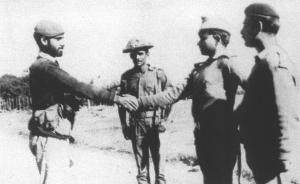
The battle
The main objective of the Indian Army was to control Bogra, thereby cutting off Pakistan forces in the north from the rest of East Pakistan. The best way of getting to Bogra was through Hilli. The frontal assault on the Pakistan fortifications took a huge toll on both sides before Indian forces finally broke through by establishing a block in the read of Pakistani forces in Hilli, upon which the 4FF Battalion in Hilli was withdrew for the defence of Bogra.Indian forces
The Indian side consisted of the 20 Indian Mountain Division led by Maj-Gen. Lachhman Singh. The constituent units of this division were 66 Brigade, 165 Brigade, 202 Brigade and 340 Brigade (all infantry units), 3 Armoured Brigade, 471 Engineer Brigade and two artillery brigades augmented by 33 Corps Artillery. The ground troops were aided by aerial support provided by the Indian Air Force which had acquired air superiority in the east and were armed with rockets, guns and 100 lb bombs.Pakistani forces
On the Pakistan side, the Area of Responsibility (AOR) was on 205 Brigade of Pakistan Army led by Brigadier (later retired as Major General) Tajammul Hussain Malik. He had joined the brigade 4 days ago, when he volunteered to leave GHQ, Rawalpindi and command troops in the East Pakistan. He put up a stiff resistance that earned praise from many quarters.Major events of the battle
Malik had placed screens along the railway line nearby and at the Railway Station complex in the area. The defensive positions were sited in depth to cover all routes leading into East Pakistan. They fought the entire Indian division and the Mukti Bahini soldiers until the Indians decided to bypass Hilli and establish a block in its rear. Brig. Malik then withdrew the forces in Hilli to avoid being cut off and to defend for the Bogra itself.Bogra was surrounded from all sides by the greater numbers of the Indian army and the Mukti Bahini. Brig. Malik's resistance continued even after the Pakistani Eastern Command surrendered in Dacca on 16 December. He, in his staff car with flags and stars uncovered went around the streets of Bogra motivating his soldiers to keep fighting. The Indian army had by then, surrounded the city of Bogra. The Brigade Major along with some 50 ORs surrendered but the Brigadier still full of vigour refused to give up.
Brig. Malik ordered the rest of his brigade to break out in small groups to Naogong, where one of his units was still fighting on. However en route, his jeep was ambushed, severely injuring him and his orderly. Muktis captured both of them and subjected them to torture. They broke his arms and split his head after which he was taken semi-conscious to an Indian army hospital. Major General Nazar Hussain Shah, was especially flown in from Natore for the surrender of this brigade on 18 December 1971, due to the refusal of Brigadier Malik. Upon return from captivity, he was the only brigadier out of 32 or so who fought the 1971 War in East Pakistan to have been promoted to Major General rank.
Significance
The battle was a significant one as it involved great personal valour on both sides. This is highlighted by the fact that soldiers on either side won their nation's highest military honours. One of the infantry battalions of the 20 Indian Mountain Division 5/11 Gorkha Rifles distinguished itself here and later earned the battle honour Bogra for itself, the commanding officer of the Indian battalion, then Lt Col F T Dias later rose to the rank of Lieutenant General in the Indian Army. In fact other than the battalion commander one of the company commanders, then Maj J B S Yadava become Lieutenant General and Maj Abjeet Mamik rose to become a Brigadier and Capt B K Bopanna later become Lieutenant General in the Indian Armed Forces, which is a unique honour to the soldiers of an army.This battle was also unique in that it had started before the official start of the India Pakistan war but continued right until the formal surrender of Pakistan. Unlike other battles in the East where the Indian army dominated, Pakistan forces gave a very good account of themselves before the combined might of the Indian military managed to occupy the area. The Indians were so impressed by General Tajammul Hussain Malik’s fighting tactics that after the war the Indians had sent a team of experts to study the battle on the ground and determine reasons why such a heavy force as described above could not break through that sector until the end.



















0 comments:
Post a Comment